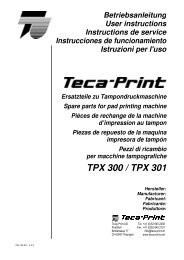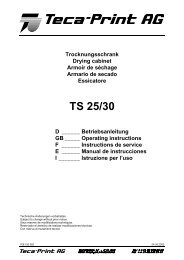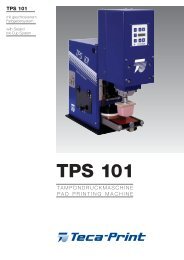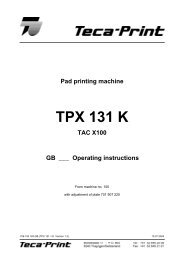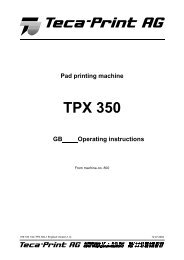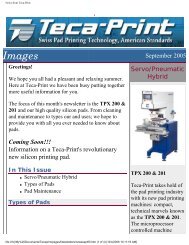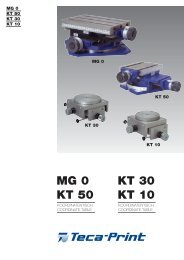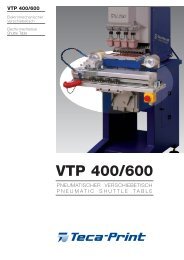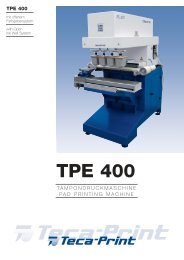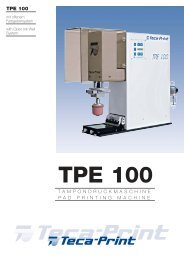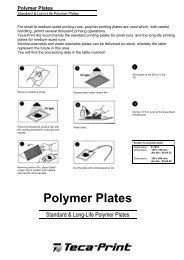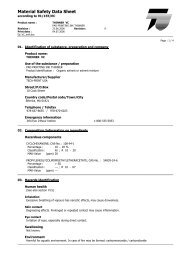TPC 200 - Teca-Print
TPC 200 - Teca-Print
TPC 200 - Teca-Print
Create successful ePaper yourself
Turn your PDF publications into a flip-book with our unique Google optimized e-Paper software.
Material Safety Data Sheet<br />
according to 91/155/EC<br />
Product name : <strong>TPC</strong> <strong>200</strong><br />
Revision : 11.07.<strong>200</strong>6 Version : 8.0.0<br />
<strong>Print</strong> date : 24.07.<strong>200</strong>6<br />
Sd_<strong>200</strong>_en9.doc<br />
01. Identification of substance, preparation and company<br />
Product name:<br />
<strong>TPC</strong> <strong>200</strong><br />
Use of the substance / preparation<br />
TAMPONDRUCKFARBE - PAD PRINTING INK - ENCRE DE TAMPOGRAPHIE - TINTA DE TAMPOGRAFÍA<br />
Manufacturer/Supplier<br />
TECA-PRINT USA<br />
Street/P.O.Box<br />
10 Cook Street<br />
Country code/Postal code/Town/City<br />
Billerica, MA 01821<br />
Telephone / Telefax<br />
978-667-8655 / 978-670-6023<br />
Emergency information<br />
InfoTrac >>> 24 h daily : 1-800-535-5053<br />
02. Composition/information on ingredients<br />
Hazardous components<br />
2-BUTOXYETHYL ACETATE ; EC-No. : 203-933-3 ; CAS-No. : 112-07-2<br />
Percentage : 10 … 25 %<br />
Classification : Xn ; R 20/21<br />
2-METHOXY-1-METHYLETHYL ACETATE ; EC-No. : 203-603-9 ; CAS-No. : 108-65-6<br />
Percentage : 10 - 20 %<br />
Classification : R 10 Xi ; R 36<br />
Page : 1 / 7<br />
REACTION PRODUCT: BISPHENOL A-(EPICHLORHYDRIN), EPOXY RESIN (NUMBER AVERAGE MOLECULAR WEIGHT<br />
Material Safety Data Sheet<br />
according to 91/155/EC<br />
Product name : <strong>TPC</strong> <strong>200</strong><br />
Revision : 11.07.<strong>200</strong>6 Version : 8.0.0<br />
<strong>Print</strong> date : 24.07.<strong>200</strong>6<br />
Sd_<strong>200</strong>_en9.doc<br />
Page : 2 / 7<br />
Hazard designation<br />
Flammable. · May cause sensitisation by skin contact. · Harmful to aquatic organisms, may cause long-term adverse<br />
effects in the aquatic environment. · Harmful by inhalation and in contact with skin. · Irritating to eyes and skin.<br />
Classification : R 10 · R 43 · R 52/53 · Xn ; R 20/21 · Xi ; R 36/38<br />
04. First-aid measures<br />
General<br />
In all cases of doubt, or when symptoms persist, seek medical attention. Never give anything by mouth to an<br />
unconscious person. Unconsciousness: lateral position - call a physician.<br />
After inhalation<br />
Remove concerned person out of danger area. Take the casualty into the fresh air and keep warm. Irregular<br />
breathing/no breathing: artificial respiration.<br />
After skin contact<br />
Wash away with soap and water and rinse. Do NOT use solvents or thinners.<br />
After eye contact<br />
Remove contact lenses, keep eyelids open. Flush with plenty of water (10 - 15 min.). Call a physician.<br />
After ingestion<br />
Do not induce vomiting - call a physician. Keep at rest.<br />
05. Fire-fighting measures<br />
Suitable extinguishing media<br />
Alcohol resistant foam, CO2, powders, water spray.<br />
Unsuitable extinguishing media<br />
Water jet.<br />
Special risk posed by the substance or by the actual preparation, its combustion products or<br />
gases discharged<br />
Fire will produce dense black smoke. Exposure to decomposition products may cause a health hazard.<br />
Special protective equipment<br />
Appropriate breathing apparatus may be required.<br />
Additional information<br />
Cool endangered containers with water in case of fire. Do not allow the quenching water into the sewage system.<br />
06. Accidental release measures<br />
Personal precautions<br />
Remove ignition sources. Provide for sufficient ventilation. Refer to protective measures listed in sections 7/8.<br />
Environmental precautions<br />
Do not empty into drains. If the product contaminates lakes, rivers or sewages, inform appropriate authorities in<br />
accordance with local regulations.<br />
Methods for cleaning up/collecting<br />
Contain and collect spillage with non-combustible absorbent materials, e.g. sand, earth, vermiculite, diatomaceous<br />
earth and place in container for disposal according to local regulations (see section 13). Clean preferably with a<br />
detergent; avoid use of solvents.<br />
07. Handling and storage
Material Safety Data Sheet<br />
according to 91/155/EC<br />
Product name : <strong>TPC</strong> <strong>200</strong><br />
Revision : 11.07.<strong>200</strong>6 Version : 8.0.0<br />
<strong>Print</strong> date : 24.07.<strong>200</strong>6<br />
Sd_<strong>200</strong>_en9.doc<br />
Page : 3 / 7<br />
Information for safe handling<br />
Prevent the creation of inflammable or explosive concentrations of vapour in air and avoid vapour concentrations<br />
higher than the OEL (=Occupational Exposure Limit). Additionally, the product should only be used in areas from which<br />
all naked lights and other sources of ignition have been excluded. Comply with the health and safety at work laws.<br />
Information about protection against explosions and fires<br />
Vapours are heavier than air and may spread along floors. Vapours may form explosive mixtures with air.<br />
Requirements to be met by storerooms and containers<br />
Containers which are opened must be carefully resealed and kept upright to prevent leakage.<br />
Information about separation of incompatible products<br />
Keep away from oxidizing agents, from strongly alkaline and strongly acid materials.<br />
Further information about storage conditions<br />
Always keep in containers of same material as the original one. See also instructions on the label. Avoid heating and<br />
direct sunlight.<br />
08. Exposure controls and personal protection<br />
Provide adequate ventilation. Where reasonably practicable this should be achieved by the use of local exhaust<br />
ventilation and good general extraction. If these are not sufficient to maintain concentrations of particulates and solvent<br />
vapour below the OEL (Occupational Exposure Limit), suitable respiratory protection must be worn.<br />
Components with critical values that require monitoring at the workplace (exposure limits)<br />
2-BUTOXYETHYL ACETATE ; CAS-No. : 112-07-2<br />
Specification : Short term exposure limit ( EC )<br />
Value : 50 ppm / 333 mg/m 3<br />
Remarks : H<br />
Version date : 08.06.<strong>200</strong>0<br />
Specification : threshold limit value ( EC )<br />
Value : 20 ppm / 133 mg/m 3<br />
Remarks : H<br />
Version date : 08.06.<strong>200</strong>0<br />
2-METHOXY-1-METHYLETHYL ACETATE ; CAS-No. : 108-65-6<br />
Specification : Short term exposure limit ( EC )<br />
Value : 100 ppm / 550 mg/m 3<br />
Remarks : H<br />
Version date : 08.06.<strong>200</strong>0<br />
Specification : threshold limit value ( EC )<br />
Value : 50 ppm / 275 mg/m 3<br />
Remarks : H<br />
Version date : 08.06.<strong>200</strong>0<br />
CYCLOHEXANONE ; CAS-No. : 108-94-1<br />
Specification : Short term exposure limit ( EC )<br />
Value : 20 ppm / 81,6 mg/m 3<br />
Remarks : H<br />
Version date : 08.06.<strong>200</strong>0<br />
Specification : threshold limit value ( EC )<br />
Value : 10 ppm / 40,8 mg/m 3<br />
Remarks : H
Material Safety Data Sheet<br />
according to 91/155/EC<br />
Product name : <strong>TPC</strong> <strong>200</strong><br />
Revision : 11.07.<strong>200</strong>6 Version : 8.0.0<br />
<strong>Print</strong> date : 24.07.<strong>200</strong>6<br />
Sd_<strong>200</strong>_en9.doc<br />
Version date : 08.06.<strong>200</strong>0<br />
Specification : Short term exposure limit ( GB )<br />
Value : 100 ml/m 3 / 400 mg/m 3<br />
Version date : 01.01.1989<br />
Specification : threshold limit value ( GB )<br />
Value : 25 ml/m 3 / 100 mg/m 3<br />
Version date : 01.01.1989<br />
XYLENE ; CAS-No. : 1330-20-7<br />
Specification : Short term exposure limit ( EC )<br />
Value : 100 ppm / 442 mg/m 3<br />
Remarks : H<br />
Version date : 08.06.<strong>200</strong>0<br />
Specification : threshold limit value ( EC )<br />
Value : 50 ppm / 221 mg/m 3<br />
Remarks : H<br />
Version date : 08.06.<strong>200</strong>0<br />
Specification : Short term exposure limit ( GB )<br />
Value : 150 ml/m 3 / 650 mg/m 3<br />
Version date : 01.01.1989<br />
Specification : threshold limit value ( GB )<br />
Value : 100 ml/m 3 / 435 mg/m 3<br />
Version date : 01.01.1989<br />
Personal protective equipment<br />
Page : 4 / 7<br />
Respiratory protection<br />
If workplace limits are exceeded, a gas mask approved for this purpose must be worn.<br />
Hand protection<br />
Solvent-resistant protective gloves must be worn. After washing hands replace lost skin fat by fat containing skin<br />
creams. Protective gloves tested according to EN 374 are advised. For short term contact use gloves with protection<br />
index of 2 or more (accordingly > 30 minutes of permeation time). For long term contact use gloves with protection<br />
index of 6 (accordingly > 480 minutes of permeation time).<br />
Eye protection<br />
Use safety glasses.<br />
Body protection<br />
Personal should wear antistatic clothing made of natural fiber or of high temperature resistant synthetic fiber. All<br />
parts of the body should be washed after contact. Use appropriate skin protection cream before work.<br />
09. Physical and chemical properties<br />
Image<br />
Form : Viscous.<br />
Colour : Coloured.<br />
Odour : Like solvent.<br />
Relevant safety data<br />
Boiling point / range : ( 1013 hPa ) 137 - 215 °C literature<br />
Flash point : ca. 43 °C<br />
Ignition temperature : <strong>200</strong> - 300 °C<br />
Lower explosion limit : 0,6 % b.v. literature<br />
Upper explosion limit : 10 % b.v. literature
Material Safety Data Sheet<br />
according to 91/155/EC<br />
Product name : <strong>TPC</strong> <strong>200</strong><br />
Revision : 11.07.<strong>200</strong>6 Version : 8.0.0<br />
<strong>Print</strong> date : 24.07.<strong>200</strong>6<br />
Sd_<strong>200</strong>_en9.doc<br />
Vapour pressure : ( 50 °C ) < 1000 hPa<br />
Vapour pressure : ( 20 °C ) ca. 10 hPa literature<br />
Density : ( 20 °C ) 1,05 - 1,7 g/cm 3<br />
Solubility in water : ( 20 °C ) insoluble<br />
pH value : not applicable<br />
10. Stability and reactivity<br />
Conditions to avoid<br />
Stable under recommended storage and handling conditions(See section 7).<br />
Page : 5 / 7<br />
Materials to avoid<br />
Keep away from oxidizing agents, strongly alkaline and strongly acid materials in order to avoid exothermic reactions.<br />
Hazardous decomposition products<br />
When exposed to high temperatures may produce hazardous decomposition products such as carbon monoxide and<br />
dioxide, smoke, oxides of nitrogen.<br />
11. Toxicological information<br />
Experience on practice<br />
This product is unlikely to harm health, given normal and proper handling and hygienic precautions. Prolonged<br />
inhalation of vapours in high concentrations may lead to headache, giddiness and nausea. In case of contact with the<br />
product: danger of resorption through the skin, irritation of skin/mucous membranes.<br />
Additional toxicological information<br />
The product was classified in toxicological terms on the basis of the results of the calculation procedure outlined within<br />
General Directive on Preparations (1999/45/EC).<br />
12. Ecological information<br />
Additional ecological information<br />
General ecological information<br />
Do not empty into waters or drains. Toxic effect on fishes and micro- organisms.<br />
13. Disposal considerations<br />
Product<br />
Do not empty into waters or drains. Can be taken to a suitable incineration centre in observance of local regulations.<br />
Waste key<br />
ABFALLSCHLÜSSEL nach AVV/EWC 08 03 14 Druckfarbenschlämme, die<br />
Die empfohlene Abfalleinstufung bezieht sich nur auf den reinen Druckfarbenabfall.<br />
gefährliche Stoffe enthalten.<br />
Contaminated packaging<br />
Recommendation<br />
Empty containers should be scrapped or reconditioned. Containers, which have not been emptied properly must be<br />
treated as special waste.<br />
14. Transportinformation<br />
Land transport ADR/RID<br />
Classification<br />
Class : 3 Kemlercode : 30
Material Safety Data Sheet<br />
according to 91/155/EC<br />
Product name : <strong>TPC</strong> <strong>200</strong><br />
Revision : 11.07.<strong>200</strong>6 Version : 8.0.0<br />
<strong>Print</strong> date : 24.07.<strong>200</strong>6<br />
Sd_<strong>200</strong>_en9.doc<br />
Substance number : 1210 Classification-Code : F1<br />
ADR : - (
Material Safety Data Sheet<br />
according to 91/155/EC<br />
Product name : <strong>TPC</strong> <strong>200</strong><br />
Revision : 11.07.<strong>200</strong>6 Version : 8.0.0<br />
<strong>Print</strong> date : 24.07.<strong>200</strong>6<br />
Sd_<strong>200</strong>_en9.doc<br />
Page : 7 / 7<br />
61 Avoid release to the environment. Refer to special instructions/Safety data sheets.<br />
35 This material and its container must be disposed of in a safe way.<br />
51 Use only in well-ventilated areas.<br />
36/37 Wear suitable protective clothing and gloves.<br />
26 In case of contact with eyes, rinse immediately with plenty of water and seek medical advice.<br />
Special designation for certain preparations<br />
92 Contains epoxy constituents. See information supplied by the manufacturer.<br />
International regulatory information<br />
Content VOC (EC) : 51.3 % b.w.<br />
16. Other information<br />
Further information<br />
The details in this material safety data sheet satisfy national and EU legislation. We have no knowledge or control over<br />
the users working conditions however. The product may not be used for any purpose other than that specified in<br />
chapter 1 unless written consent has been obtained. The user is responsible for the observance of all required<br />
statutory provisions.<br />
Relevant changes<br />
14. Proper shipping name (ADR) · 14. Proper shipping name (IMDG) · 14. Proper shipping name (ICAO)<br />
R-Phrases of components<br />
10 Flammable.<br />
20 Harmful by inhalation.<br />
20/21 Harmful by inhalation and in contact with skin.<br />
36 Irritating to eyes.<br />
36/37/38 Irritating to eyes, respiratory system and skin.<br />
36/38 Irritating to eyes and skin.<br />
38 Irritating to skin.<br />
43 May cause sensitisation by skin contact.<br />
51/53 Toxic to aquatic organisms, may cause long-term adverse effects in the aquatic environment.<br />
65 Harmful: may cause lung damage if swallowed.<br />
66 Repeated exposure may cause skin dryness or cracking.<br />
67 Vapours may cause drowsiness and dizziness.<br />
These data are based on our present knowledge. However, they shall not constitute a guarantee for any specific product<br />
features and shall not establish a legally valid contractual relationship.



